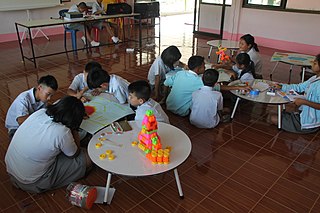Related Research Articles

Learning theory describes how students receive, process, and retain knowledge during learning. Cognitive, emotional, and environmental influences, as well as prior experience, all play a part in how understanding, or a worldview, is acquired or changed and knowledge and skills retained.
A teaching method is a set of principles and methods used by teachers to enable student learning. These strategies are determined partly on subject matter to be taught and partly by the nature of the learner. For a particular teaching method to be appropriate and efficient it has take into account the learner, the nature of the subject matter, and the type of learning it is supposed to bring about.
Professional development, also known as professional education, is learning that leads to or emphasizes education in a specific professional career field or builds practical job applicable skills emphasizing praxis in addition to the transferable skills and theoretical academic knowledge found in traditional liberal arts and pure sciences education along side exposure to practice-based professional learning. It is used to earn or maintain professional credentials such as professional certifications or academic degrees through formal coursework at institutions known as professional schools, or attending conferences and informal learning opportunities to strengthen or gain new skills.

Pedagogy, from Ancient Greek παιδαγωγία (paidagōgía), most commonly understood as the approach to teaching, is the theory and practice of learning, and how this process influences, and is influenced by, the social, political and psychological development of learners. Pedagogy, taken as an academic discipline, is the study of how knowledge and skills are imparted in an educational context, and it considers the interactions that take place during learning. Both the theory and practice of pedagogy vary greatly as they reflect different social, political, and cultural contexts.

In education, a curriculum is broadly defined as the totality of student experiences that occur in the educational process. The term often refers specifically to a planned sequence of instruction, or to a view of the student's experiences in terms of the educator's or school's instructional goals. A curriculum may incorporate the planned interaction of pupils with instructional content, materials, resources, and processes for evaluating the attainment of educational objectives. Curricula are split into several categories: the explicit, the implicit, the excluded, and the extracurricular.
A didactic method is a teaching method that follows a consistent scientific approach or educational style to present information to students. The didactic method of instruction is often contrasted with dialectics and the Socratic method; the term can also be used to refer to a specific didactic method, as for instance constructivist didactics.
A KWL table, or KWL chart, is a graphical organizer designed to help in learning. The letters KWL are an acronym, for what students, in the course of a lesson, already know, want to know, and ultimately learn. It is a part of the constructivist teaching method where students move away from what are considered traditional methods of teaching and learning. In this particular methodology the students are given the space to learn by constructing their own learning pace and their own style of understanding a given topic or idea. The KWL chart or table was developed within this methodology and is a form of instructional reading strategy that is used to guide students taking them through the idea and the text. A KWL table is typically divided into three columns titled Know, Want and Learned. The table comes in various forms as some have modified it to include or exclude information.

Project-based learning (PBL) is a student-centered pedagogy that involves a dynamic classroom approach in which it is believed that students acquire a deeper knowledge through active exploration of real-world challenges and problems. Students learn about a subject by working for an extended period of time to investigate and respond to a complex question, challenge, or problem. It is a style of active learning and inquiry-based learning. PBL contrasts with paper-based, rote memorization, or teacher-led instruction that presents established facts or portrays a smooth path to knowledge by instead posing questions, problems, or scenarios.

The Carnegie Foundation for the Advancement of Teaching (CFAT) is a U.S.-based education policy and research center. It was founded by Andrew Carnegie in 1905 and chartered in 1906 by an act of the United States Congress. Among its most notable accomplishments are the development of the Teachers Insurance and Annuity Association (TIAA), the Flexner Report on medical education, the Carnegie Unit, the Educational Testing Service, and the Carnegie Classification of Institutions of Higher Education.
A lesson plan is a teacher's detailed description of the course of instruction or "learning trajectory" for a lesson. A daily lesson plan is developed by a teacher to guide class learning. Details will vary depending on the preference of the teacher, subject being covered, and the needs of the students. There may be requirements mandated by the school system regarding the plan. A lesson plan is the teacher's guide for running a particular lesson, and it includes the goal, how the goal will be reached and a way of measuring how well the goal was reached.
Formative assessment, formative evaluation, formative feedback, or assessment for learning, including diagnostic testing, is a range of formal and informal assessment procedures conducted by teachers during the learning process in order to modify teaching and learning activities to improve student attainment. The goal of a formative assessment is to monitor student learning to provide ongoing feedback that can help students identify their strengths and weaknesses and target areas that need work. It also helps faculty recognize where students are struggling and address problems immediately. It typically involves qualitative feedback for both student and teacher that focuses on the details of content and performance. It is commonly contrasted with summative assessment, which seeks to monitor educational outcomes, often for purposes of external accountability.
Language teaching, like other educational activities, may employ specialized vocabulary and word use. This list is a glossary for English language learning and teaching using the communicative approach.

Backward design is a method of designing an educational curriculum by setting goals before choosing instructional methods and forms of assessment. Backward design of curriculum typically involves three stages:
- Identify the results desired
- Determine acceptable levels of evidence that support that the desired results have occurred
- Design activities that will make desired results happen
Dogme language teaching is considered to be both a methodology and a movement. Dogme is a communicative approach to language teaching that encourages teaching without published textbooks and focuses instead on conversational communication among learners and teacher. It has its roots in an article by the language education author, Scott Thornbury. The Dogme approach is also referred to as "Dogme ELT", which reflects its origins in the ELT sector. Although Dogme language teaching gained its name from an analogy with the Dogme 95 film movement in which the directors, actors, and actresses commit a "vow of chastity" to minimize their reliance on special effects that may create unauthentic feelings from the viewers, the connection is not considered close.
Language pedagogy is the discipline concerned with the theories and techniques of teaching language. It has been described as a type of teaching wherein the teacher draws from their own prior knowledge and actual experience in teaching language. The approach is distinguished from research-based methodologies.

Katharine Moana Birbalsingh is a British teacher and education reform advocate who is the founder and head teacher of Michaela Community School, a free school established in 2014 in Wembley Park, London. Politically, she identifies as a small-c conservative.

Differentiated instruction and assessment, also known as differentiated learning or, in education, simply, differentiation, is a framework or philosophy for effective teaching that involves providing all students within their diverse classroom community of learners a range of different avenues for understanding new information in terms of: acquiring content; processing, constructing, or making sense of ideas; and developing teaching materials and assessment measures so that all students within a classroom can learn effectively, regardless of differences in their ability.Differentiated instruction means using different tools, content, and due process in order to successfully reach all individuals. Differentiated instruction, according to Carol Ann Tomlinson, is the process of "ensuring that what a student learns, how he or she learns it, and how the student demonstrates what he or she has learned is a match for that student's readiness level, interests, and preferred mode of learning." According to Boelens et al. (2018), differentiation can be on two different levels: the administration level and the classroom level. The administration level takes the socioeconomic status and gender of students into consideration. At the classroom level, differentiation revolves around content, processing, product, and effects. On the content level, teachers adapt what they are teaching to meet the needs of students. This can mean making content more challenging or simplified for students based on their levels. The process of learning can be differentiated as well. Teachers may choose to teach individually at a time, assign problems to small groups, partners or the whole group depending on the needs of the students. By differentiating product, teachers decide how students will present what they have learned. This may take the form of videos, graphic organizers, photo presentations, writing, and oral presentations. All these take place in a safe classroom environment where students feel respected and valued—effects.
The 8 Learning Management Questions is a set of questions developed in and primarily used in Australia for teacher training and curriculum development. This sequential design-based set of questions is designed to assist teachers in developing a teaching plan for their classrooms, with a focus on achieving the intended learning outcomes for all students. The process is focused on enabling teachers to translate teaching theory into practice.
Joe Kirby is a British school teacher and director of education at Athena Learning Trust, known for creating and making popular the use of knowledge organisers, a template used by teachers and their students to clarify what is essential to learn.
Harris Academy Ockendon is a coeducational secondary school and sixth form with academy status, located in South Ockendon in the Thurrock area of Essex, England.
References
- 1 2 Runeckles, Chris (2018). "4. Present it differently". Making every history lesson count: Six principles to support great history teaching. Crown House Publishing. p. 91. ISBN 978-1-78583-379-3.
- ↑ Sharpe, Helen (11 March 2018). "5 Ways To Make Knowledge Stick". TeacherToolkit. Retrieved 14 November 2019.
- ↑ Tharby, Andy (2017). Making every English lesson count: Six principles to support great reading and writing. Crown House Publishing Ltd. ISBN 9781785832512.
- ↑ Miller, Mark (September 2018). "Organising knowledge: The purpose and pedagogy of knowledge organisers". Impact: Journal of the Chartered College of Teaching. The Chartered College of Teaching.
- ↑ Facer, Jo (2019). Simplicity Rules: How Simplifying What We Do in the Classroom Can Benefit Children. Routledge. ISBN 978113848863-2.
- ↑ "Swindon Academy > Secondary > Prep Guidance > Knowledge Organisers". www.swindon-academy.org. Retrieved 8 November 2020. (with video link)
- ↑ Turner, Summer; Library, Bloomsbury CPD (2016). Bloomsbury CPD Library: Secondary Curriculum and Assessment Design. Bloomsbury Publishing. pp. 141–145. ISBN 9781472928511.